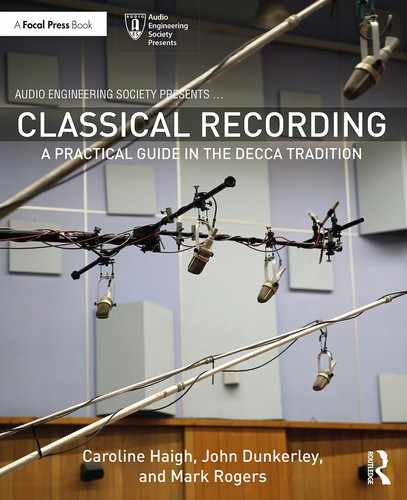Book Description
Classical Recording: A Practical Guide in the Decca Tradition is the authoritative guide to all aspects of recording acoustic classical music. Offering detailed descriptions, diagrams, and photographs of fundamental recording techniques such as the Decca tree, this book offers a comprehensive overview of the essential skills involved in successfully producing a classical recording. Written by engineers with years of experience working for Decca and Abbey Road Studios and as freelancers, Classical Recording equips the student, the interested amateur, and the practising professional with the required knowledge and confidence to tackle everything from solo piano to opera.
Book Description
Classical Recording: A Practical Guide in the Decca Tradition is the authoritative guide to all aspects of recording acoustic classical music. Offering detailed descriptions, diagrams, and photographs of fundamental recording techniques such as the Decca tree, this book offers a comprehensive overview of the essential skills involved in successfully producing a classical recording. Written by engineers with years of experience working for Decca and Abbey Road Studios and as freelancers, Classical Recording equips the student, the interested amateur, and the practising professional with the required knowledge and confidence to tackle everything from solo piano to opera.
Table of Contents
- Cover
- Half Title
- Series
- Title
- Copyright
- Dedication
- Contents
- Acknowledgements
- Introduction
- Glossary of terms, acronyms, and abbreviations
- Glossary of recording attributes
- Part I Before recording
- Part II Recording
- 3 Basic two-microphone stereo techniques
- 4 Solo instruments
- 5 The piano
- 6 Voice: solo and accompanied
- 6.1 The singer in a recording session
- 6.2 The classical voice and microphone placement
- 6.3 Using two microphones on the voice
- 6.4 Microphone choice
- 6.5 Use of ambient pairs
- 6.6 Concert recording layout
- 6.7 Studio recording and reverse concert positions
- 6.8 Classical voice and lute/theorbo/guitar
- 6.9 Mixing and fader riding for a singer
- 7 Solo instruments and piano
- 8 The Decca Tree
- 9 Ancillary microphones
- 9.1 What do we mean by ‘ancillary’?
- 9.2 Perception of orchestral depth and perspective
- 9.3 General notes on placement of ancillary microphones
- 9.4 Panning and levels of ancillary microphones
- 9.5 Woodwinds
- 9.6 Brass
- 9.7 Percussion
- 9.8 Double bass section
- 9.9 Other string sectional microphones
- 9.10 Harp
- 9.11 Celeste
- 10 Surround sound techniques
- 10.1 Purpose of surround sound in classical music recording
- 10.2 Panning a Decca Tree in 5.1 surround
- 10.3 Natural reverberation: additional microphones for 5.1 surround
- 10.4 Artificial reverberation in 5.1 surround
- 10.5 Offstage effects in surround: location of sources behind the listener
- 10.6 Object-based audio: Dolby Atmos
- 11 Solo instruments and orchestra
- 11.1 Piano concerto: studio layouts
- 11.2 Single piano concerto: concert layout
- 11.3 Piano concerto conducted from the keyboard
- 11.4 A note on the size of the grand piano
- 11.5 Violin concerto: studio layouts
- 11.6 Violin concerto: concert layout
- 11.7 Wind concertos: studio and concert layouts
- 11.8 Cello concerto: studio and concert layouts
- 11.9 Guitar concerto: studio layout
- 11.10 Brass concertos: studio and concert layouts
- 11.11 Percussion concertos
- 12 Chamber ensembles
- 13 Wind, brass, and percussion bands
- 14 Organ
- 14.1 Brief introduction to the pipe organ
- 14.2 Doing a venue reconnoitre
- 14.3 Microphone choices, stands, and cable runs
- 14.4 Basic technique: straightforward organ layout
- 14.5 Organs with pipe divisions in several locations
- 14.6 Interesting acoustic effects and other awkward corners
- 14.7 Monitoring limitations
- 14.8 Communication: talk microphone
- 14.9 Noise
- 14.10 Electronic organs
- 14.11 Organ with orchestra: overdubbing or simultaneous recording
- 14.12 Organ pitch
- 14.13 Sampled organs
- 15 Choirs
- 16 Solo voice, orchestra, and choir
- Part III After the recording session
- 17 Mixing
- 18 Editing and post-production
- 18.1 Aims and philosophy of editing
- 18.2 Requirements of a classical editing system
- 18.3 Source-destination editing
- 18.4 Classical post-production workflow
- 18.5 Refining edits: how to solve problems and maintain musical flow
- 18.6 Notes on working with different instruments
- 18.7 Overdubbing scenarios
- 18.8 Emergency measures: sampling piano notes and note removal
- 18.9 Professional finish: joining into room tone
- 19 Mastering
- Appendices
- Bibliography and further reading
- Index
